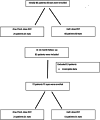Comparative efficacy of half-dose and one-third-dose photodynamic therapy in chronic central serous chorioretinopathy: a retrospective study
- PMID: 40102960
- PMCID: PMC11921750
- DOI: 10.1186/s40942-025-00657-6
Comparative efficacy of half-dose and one-third-dose photodynamic therapy in chronic central serous chorioretinopathy: a retrospective study
Abstract
Purpose: To compare the efficacy and safety of half-dose and one-third-dose photodynamic therapy (PDT) with verteporfin in patients with chronic central serous chorioretinopathy (CSC).
Methods: This retrospective study included 72 eyes from 72 patients with chronic CSC treated with either one-third-dose (2 mg/m²) or half-dose (3 mg/m²) PDT. Best-corrected visual acuity (BCVA), central retinal thickness (CRT), subretinal fluid (SRF) thickness, subfoveal choroidal thickness (SFCT), and optical coherence tomography (OCT) features were evaluated at baseline, 3 months, and 12 months. Fluorescein angiography (FA) was used to guide laser application. Treatment outcomes, including SRF resolution, BCVA gain, and recurrence rates, were compared between the two groups.
Results: At 12 months, complete SRF resolution was achieved in 40 eyes (78.4%) in the half-dose group and 15 eyes (71.4%) in the one-third-dose group. The recurrence rate of SRF was significantly higher in the one-third-dose group (20%) compared to the half-dose group (7.5%) (P =.015). BCVA improved significantly in both groups, with mean increases from 72.4 ± 3.9 to 77.1 ± 5.6 letters in the one-third-dose group and from 74.4 ± 4.2 to 80.2 ± 2.19 letters in the half-dose group. The proportion of patients achieving a ≥ 10-letter gain was higher in the half-dose group (52%) compared to the one-third-dose group (28.5%, P =.001). Both groups exhibited significant reductions in CRT, SRF thickness, and SFCT (P <.001), with no significant intergroup differences. Baseline CRT and fluorescein leakage patterns influenced treatment response.
Conclusions: Both one-third-dose and half-dose PDT effectively improved visual and anatomical outcomes in patients with chronic CSC. However, half-dose PDT demonstrated superior efficacy in achieving SRF resolution and greater visual acuity gains with a lower recurrence rate.
Clinical trial number: Not applicable.
Keywords: Choroidal thickness changes; Chronic central serous chorioretinopathy (CSC); Reduced-dose photodynamic therapy (PDT); Subretinal fluid resolution; Visual acuity improvement.
© 2025. The Author(s).
Conflict of interest statement
Declarations. Ethics approval and consent to participate: The protocol used in this study was approved by the Ethics Committee of Shiraz University of Medical Sciences (IR.SUMS.MED.REC.1403.494), All methods were performed in accordance with the relevant guidelines and regulations (Declaration of Helsinki) the requirement for informed patient consent was waived due to the study’s retrospective design. Consent for publication: Not applicable. Competing interests: The authors declare no competing interests.
Figures



Similar articles
-
Comparison between the outcomes of fluorescein angiography-guided and indocyanine green angiography-guided half-time photodynamic therapy for central serous chorioretinopathy.Photodiagnosis Photodyn Ther. 2020 Sep;31:101955. doi: 10.1016/j.pdpdt.2020.101955. Epub 2020 Aug 18. Photodiagnosis Photodyn Ther. 2020. PMID: 32818640
-
One-year results of half-dose versus one-third-dose photodynamic therapy in chronic or recurrent central serous chorioretinopathy.BMC Ophthalmol. 2021 Jan 12;21(1):30. doi: 10.1186/s12886-020-01796-0. BMC Ophthalmol. 2021. PMID: 33430812 Free PMC article.
-
Clinical research on one-third dose verteporfin photodynamic therapy in the treatment of chronic central serous chorioretinopathy.Eur Rev Med Pharmacol Sci. 2018 Jan;22(2):278-284. doi: 10.26355/eurrev_201801_14169. Eur Rev Med Pharmacol Sci. 2018. PMID: 29424884
-
Visual and anatomical evaluation of navigated subthreshold micropulse laser versus photodynamic therapy in managing chronic central serous chorioretinopathy.Graefes Arch Clin Exp Ophthalmol. 2025 Feb;263(2):405-414. doi: 10.1007/s00417-024-06666-9. Epub 2024 Oct 19. Graefes Arch Clin Exp Ophthalmol. 2025. PMID: 39425791
-
Therapeutic interventions for chronic central serous chorioretinopathy: a comprehensive assessment of systematic reviews.Int J Retina Vitreous. 2025 Mar 23;11(1):34. doi: 10.1186/s40942-025-00660-x. Int J Retina Vitreous. 2025. PMID: 40122856 Free PMC article. Review.
References
-
- Yannuzzi LA. Type-A behavior and central serous chorioretinopathy. Retina. 1987;7:111–31. 10.1097/00006982-198700720-00009. - PubMed
-
- Loo RH, Scott IU, Flynn HW Jr, Gass JD, Murray TG, Lewis ML, et al. Factors associated with reduced visual acuity during long-term follow-up of patients with idiopathic central serous chorioretinopathy. Retina. 2002;22:19–24. 10.1097/00006982-200202000-00004. - PubMed
-
- Zhao M, Zhang F, Chen Y, Dai H, Qu J, Dong C, et al. A 50% vs 30% dose of verteporfin (photodynamic therapy) for acute central serous chorioretinopathy: one-year results of a randomized clinical trial. JAMA Ophthalmol. 2015;133:333–40. 10.1001/jamaophthalmol.2014.5312. - PubMed
-
- Khosla PK, Rana SS, Tewari HK, Azad RU, Talwar D. Evaluation of visual function following argon laser photocoagulation in central serous retinopathy. Ophthalmic Surg Lasers. 1997;28:693–7. - PubMed
LinkOut - more resources
Full Text Sources
Research Materials
Miscellaneous

